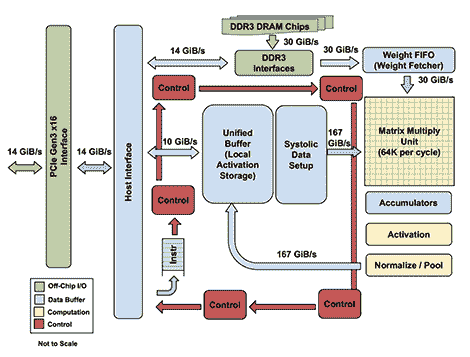# 十九、张量处理单元
**张量处理单元**(**TPU**)是**专用集成电路**(**ASIC**),它实现了针对计算要求而优化的硬件电路深度神经网络。 TPU 基于**复杂指令集计算机**(**CISC**)指令集,该指令集实现用于训练深度神经网络的复杂任务的高级指令。 TPU 架构的核心在于优化矩阵运算的脉动数组。
The Architecture of TPUImage from: https://cloud.google.com/blog/big-data/2017/05/images/149454602921110/tpu-15.png
TensorFlow 提供了一个编译器和软件栈,可将 API 调用从 TensorFlow 图转换为 TPU 指令。以下框图描述了在 TPU 栈顶部运行的 TensorFlow 模型的架构:

图像来自[这个链接](https://cloud.google.com/blog/big-data/2017/05/images/149454602921110/tpu-2.png)。TPU 架构的更多信息,阅读[博客](https://cloud.google.com/blog/big-data/2017/05/an-in-depth-look-at-googles-first-tensor-processing-unit-tpu)。
TPU 的 TensorFlow API 位于`tf.contrib.tpu`模块中。为了在 TPU 上构建模型,使用以下三个 TPU 特定的 TensorFlow 模块:
* `tpu_config`:`tpu_config`模块允许您创建配置对象,其中包含有关将运行模型的主机的信息。
* `tpu_estimator`:`tpu_estimator`模块将估计器封装在`TPUEstimatorSpec`类中。要在 TPU 上运行估计器,我们创建此类的对象。
* `tpu_optimizer`:`tpu_optimizer`模块包装优化器。例如,在下面的示例代码中,我们将`tpu_optimizer`类中的 SGD 优化器包装在`tpu_optimizer`类中。
例如,以下代码使用 TFEstimator API 为 TPU 上的 MNIST 数据集构建 CNN 模型:
以下代码改编自[这个页面](https://github.com/tensorflow/tpu-demos/blob/master/cloud_tpu/models/mnist/mnist.py)。
```py
import tensorflow as tf
from tensorflow.contrib.tpu.python.tpu import tpu_config
from tensorflow.contrib.tpu.python.tpu import tpu_estimator
from tensorflow.contrib.tpu.python.tpu import tpu_optimizer
learning_rate = 0.01
batch_size = 128
def metric_fn(labels, logits):
predictions = tf.argmax(logits, 1)
return {
"accuracy": tf.metrics.precision(
labels=labels, predictions=predictions),
}
def model_fn(features, labels, mode):
if mode == tf.estimator.ModeKeys.PREDICT:
raise RuntimeError("mode {} is not supported yet".format(mode))
input_layer = tf.reshape(features, [-1, 28, 28, 1])
conv1 = tf.layers.conv2d(
inputs=input_layer,
filters=32,
kernel_size=[5, 5],
padding="same",
activation=tf.nn.relu)
pool1 = tf.layers.max_pooling2d(inputs=conv1, pool_size=[2, 2],
strides=2)
conv2 = tf.layers.conv2d(
inputs=pool1,
filters=64,
kernel_size=[5, 5],
padding="same",
activation=tf.nn.relu)
pool2 = tf.layers.max_pooling2d(inputs=conv2, pool_size=[2, 2],
strides=2)
pool2_flat = tf.reshape(pool2, [-1, 7 * 7 * 64])
dense = tf.layers.dense(inputs=pool2_flat, units=128,
activation=tf.nn.relu)
dropout = tf.layers.dropout(
inputs=dense, rate=0.4,
training=mode == tf.estimator.ModeKeys.TRAIN)
logits = tf.layers.dense(inputs=dropout, units=10)
onehot_labels = tf.one_hot(indices=tf.cast(labels, tf.int32), depth=10)
loss = tf.losses.softmax_cross_entropy(
onehot_labels=onehot_labels, logits=logits)
if mode == tf.estimator.ModeKeys.EVAL:
return tpu_estimator.TPUEstimatorSpec(
mode=mode,
loss=loss,
eval_metrics=(metric_fn, [labels, logits]))
# Train.
decaying_learning_rate = tf.train.exponential_decay(learning_rate,
tf.train.get_global_step(),
100000,0.96)
optimizer = tpu_optimizer.CrossShardOptimizer(
tf.train.GradientDescentOptimizer(
learning_rate=decaying_learning_rate))
train_op = optimizer.minimize(loss,
global_step=tf.train.get_global_step())
return tpu_estimator.TPUEstimatorSpec(mode=mode,
loss=loss, train_op=train_op)
def get_input_fn(filename):
def input_fn(params):
batch_size = params["batch_size"]
def parser(serialized_example):
features = tf.parse_single_example(
serialized_example,
features={
"image_raw": tf.FixedLenFeature([], tf.string),
"label": tf.FixedLenFeature([], tf.int64),
})
image = tf.decode_raw(features["image_raw"], tf.uint8)
image.set_shape([28 * 28])
image = tf.cast(image, tf.float32) * (1\. / 255) - 0.5
label = tf.cast(features["label"], tf.int32)
return image, label
dataset = tf.data.TFRecordDataset(
filename, buffer_size=FLAGS.dataset_reader_buffer_size)
dataset = dataset.map(parser).cache().repeat()
dataset = dataset.apply(
tf.contrib.data.batch_and_drop_remainder(batch_size))
images, labels = dataset.make_one_shot_iterator().get_next()
return images, labels
return input_fn
# TPU config
master = 'local' #URL of the TPU instance
model_dir = '/home/armando/models/mnist'
n_iterations = 50 # number of iterations per TPU training loop
n_shards = 8 # number of TPU chips
run_config = tpu_config.RunConfig(
master=master,
evaluation_master=master,
model_dir=model_dir,
session_config=tf.ConfigProto(
allow_soft_placement=True,
log_device_placement=True
),
tpu_config=tpu_config.TPUConfig(n_iterations,
n_shards
)
)
estimator = tpu_estimator.TPUEstimator(
model_fn=model_fn,
use_tpu=True,
train_batch_size=batch_size,
eval_batch_size=batch_size,
config=run_config)
train_file = '/home/armando/datasets/mnist/train' # input data file
train_steps = 1000 # number of steps to train for
estimator.train(input_fn=get_input_fn(train_file),
max_steps=train_steps
)
eval_file = '/home/armando/datasets/mnist/test' # test data file
eval_steps = 10
estimator.evaluate(input_fn=get_input_fn(eval_file),
steps=eval_steps
)
```
有关在 TPU 上构建模型的更多示例,[请访问此链接](https://github.com/tensorflow/tpu-demos)。
- TensorFlow 1.x 深度学习秘籍
- 零、前言
- 一、TensorFlow 简介
- 二、回归
- 三、神经网络:感知器
- 四、卷积神经网络
- 五、高级卷积神经网络
- 六、循环神经网络
- 七、无监督学习
- 八、自编码器
- 九、强化学习
- 十、移动计算
- 十一、生成模型和 CapsNet
- 十二、分布式 TensorFlow 和云深度学习
- 十三、AutoML 和学习如何学习(元学习)
- 十四、TensorFlow 处理单元
- 使用 TensorFlow 构建机器学习项目中文版
- 一、探索和转换数据
- 二、聚类
- 三、线性回归
- 四、逻辑回归
- 五、简单的前馈神经网络
- 六、卷积神经网络
- 七、循环神经网络和 LSTM
- 八、深度神经网络
- 九、大规模运行模型 -- GPU 和服务
- 十、库安装和其他提示
- TensorFlow 深度学习中文第二版
- 一、人工神经网络
- 二、TensorFlow v1.6 的新功能是什么?
- 三、实现前馈神经网络
- 四、CNN 实战
- 五、使用 TensorFlow 实现自编码器
- 六、RNN 和梯度消失或爆炸问题
- 七、TensorFlow GPU 配置
- 八、TFLearn
- 九、使用协同过滤的电影推荐
- 十、OpenAI Gym
- TensorFlow 深度学习实战指南中文版
- 一、入门
- 二、深度神经网络
- 三、卷积神经网络
- 四、循环神经网络介绍
- 五、总结
- 精通 TensorFlow 1.x
- 一、TensorFlow 101
- 二、TensorFlow 的高级库
- 三、Keras 101
- 四、TensorFlow 中的经典机器学习
- 五、TensorFlow 和 Keras 中的神经网络和 MLP
- 六、TensorFlow 和 Keras 中的 RNN
- 七、TensorFlow 和 Keras 中的用于时间序列数据的 RNN
- 八、TensorFlow 和 Keras 中的用于文本数据的 RNN
- 九、TensorFlow 和 Keras 中的 CNN
- 十、TensorFlow 和 Keras 中的自编码器
- 十一、TF 服务:生产中的 TensorFlow 模型
- 十二、迁移学习和预训练模型
- 十三、深度强化学习
- 十四、生成对抗网络
- 十五、TensorFlow 集群的分布式模型
- 十六、移动和嵌入式平台上的 TensorFlow 模型
- 十七、R 中的 TensorFlow 和 Keras
- 十八、调试 TensorFlow 模型
- 十九、张量处理单元
- TensorFlow 机器学习秘籍中文第二版
- 一、TensorFlow 入门
- 二、TensorFlow 的方式
- 三、线性回归
- 四、支持向量机
- 五、最近邻方法
- 六、神经网络
- 七、自然语言处理
- 八、卷积神经网络
- 九、循环神经网络
- 十、将 TensorFlow 投入生产
- 十一、更多 TensorFlow
- 与 TensorFlow 的初次接触
- 前言
- 1. TensorFlow 基础知识
- 2. TensorFlow 中的线性回归
- 3. TensorFlow 中的聚类
- 4. TensorFlow 中的单层神经网络
- 5. TensorFlow 中的多层神经网络
- 6. 并行
- 后记
- TensorFlow 学习指南
- 一、基础
- 二、线性模型
- 三、学习
- 四、分布式
- TensorFlow Rager 教程
- 一、如何使用 TensorFlow Eager 构建简单的神经网络
- 二、在 Eager 模式中使用指标
- 三、如何保存和恢复训练模型
- 四、文本序列到 TFRecords
- 五、如何将原始图片数据转换为 TFRecords
- 六、如何使用 TensorFlow Eager 从 TFRecords 批量读取数据
- 七、使用 TensorFlow Eager 构建用于情感识别的卷积神经网络(CNN)
- 八、用于 TensorFlow Eager 序列分类的动态循坏神经网络
- 九、用于 TensorFlow Eager 时间序列回归的递归神经网络
- TensorFlow 高效编程
- 图嵌入综述:问题,技术与应用
- 一、引言
- 三、图嵌入的问题设定
- 四、图嵌入技术
- 基于边重构的优化问题
- 应用
- 基于深度学习的推荐系统:综述和新视角
- 引言
- 基于深度学习的推荐:最先进的技术
- 基于卷积神经网络的推荐
- 关于卷积神经网络我们理解了什么
- 第1章概论
- 第2章多层网络
- 2.1.4生成对抗网络
- 2.2.1最近ConvNets演变中的关键架构
- 2.2.2走向ConvNet不变性
- 2.3时空卷积网络
- 第3章了解ConvNets构建块
- 3.2整改
- 3.3规范化
- 3.4汇集
- 第四章现状
- 4.2打开问题
- 参考
- 机器学习超级复习笔记
- Python 迁移学习实用指南
- 零、前言
- 一、机器学习基础
- 二、深度学习基础
- 三、了解深度学习架构
- 四、迁移学习基础
- 五、释放迁移学习的力量
- 六、图像识别与分类
- 七、文本文件分类
- 八、音频事件识别与分类
- 九、DeepDream
- 十、自动图像字幕生成器
- 十一、图像着色
- 面向计算机视觉的深度学习
- 零、前言
- 一、入门
- 二、图像分类
- 三、图像检索
- 四、对象检测
- 五、语义分割
- 六、相似性学习
- 七、图像字幕
- 八、生成模型
- 九、视频分类
- 十、部署
- 深度学习快速参考
- 零、前言
- 一、深度学习的基础
- 二、使用深度学习解决回归问题
- 三、使用 TensorBoard 监控网络训练
- 四、使用深度学习解决二分类问题
- 五、使用 Keras 解决多分类问题
- 六、超参数优化
- 七、从头开始训练 CNN
- 八、将预训练的 CNN 用于迁移学习
- 九、从头开始训练 RNN
- 十、使用词嵌入从头开始训练 LSTM
- 十一、训练 Seq2Seq 模型
- 十二、深度强化学习
- 十三、生成对抗网络
- TensorFlow 2.0 快速入门指南
- 零、前言
- 第 1 部分:TensorFlow 2.00 Alpha 简介
- 一、TensorFlow 2 简介
- 二、Keras:TensorFlow 2 的高级 API
- 三、TensorFlow 2 和 ANN 技术
- 第 2 部分:TensorFlow 2.00 Alpha 中的监督和无监督学习
- 四、TensorFlow 2 和监督机器学习
- 五、TensorFlow 2 和无监督学习
- 第 3 部分:TensorFlow 2.00 Alpha 的神经网络应用
- 六、使用 TensorFlow 2 识别图像
- 七、TensorFlow 2 和神经风格迁移
- 八、TensorFlow 2 和循环神经网络
- 九、TensorFlow 估计器和 TensorFlow HUB
- 十、从 tf1.12 转换为 tf2
- TensorFlow 入门
- 零、前言
- 一、TensorFlow 基本概念
- 二、TensorFlow 数学运算
- 三、机器学习入门
- 四、神经网络简介
- 五、深度学习
- 六、TensorFlow GPU 编程和服务
- TensorFlow 卷积神经网络实用指南
- 零、前言
- 一、TensorFlow 的设置和介绍
- 二、深度学习和卷积神经网络
- 三、TensorFlow 中的图像分类
- 四、目标检测与分割
- 五、VGG,Inception,ResNet 和 MobileNets
- 六、自编码器,变分自编码器和生成对抗网络
- 七、迁移学习
- 八、机器学习最佳实践和故障排除
- 九、大规模训练
- 十、参考文献
